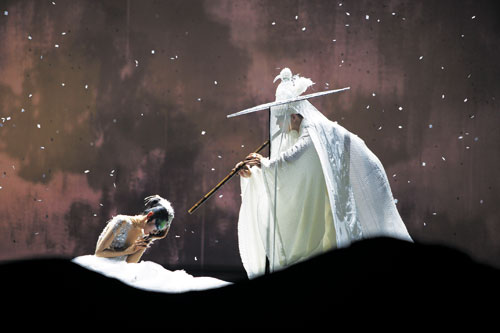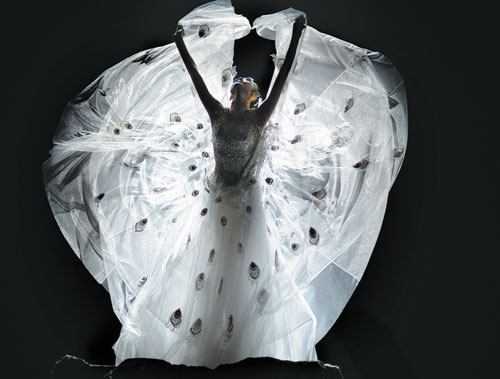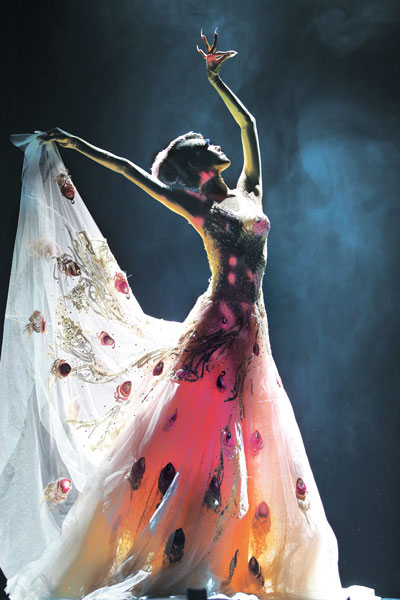
 'Taken 2' grabs movie box office crown
'Taken 2' grabs movie box office crown
 Rihanna's 'Diamonds' tops UK pop chart
Rihanna's 'Diamonds' tops UK pop chart
 Fans get look at vintage Rolling Stones
Fans get look at vintage Rolling Stones
 Celebrities attend Power of Women event
Celebrities attend Power of Women event
 Ang Lee breaks 'every rule' to make unlikely new Life of Pi film
Ang Lee breaks 'every rule' to make unlikely new Life of Pi film
 Rihanna almost thrown out of nightclub
Rihanna almost thrown out of nightclub
 'Dark Knight' wins weekend box office
'Dark Knight' wins weekend box office
 'Total Recall' stars gather in Beverly Hills
'Total Recall' stars gather in Beverly Hills
Peacock's last bow launches dance fest
Updated: 2012-10-26 09:27
By Xu Lin (China Daily)
|
||||||||
 |
|
[Photo/China Daily] |
 |
|
[Photo/China Daily] |
 |
|
[Photo/China Daily] |
Dancer and choreographer Yang Liping is bringing her latest production Peacock to the 2012 Dance Festival of the National Center for the Performing Arts. The 32-day festival will showcase 13 dance performances from home and abroad, with Peacock as its opening show.
Related: Curtain call
"I'm never a professional dancer, but am a dancer for life. The peacock dance is a kind of totem, and human belief. It's about one's life experience," says Yang, 54, from the Bai ethnic group in Yunnan province.
Related photos: Yang Liping's new dance drama to start national tour
In the 2012 Spring Festival Gala, Yang, together with the 34-year-old Wang Di, performed Love of Peacock, which demonstrates the beauty of peacocks and that Yang, even in her 50s, can still dance like a spirited youth.
"I've always been on the dancing stage, and now I want to be in the background after this performance," says Yang, who has the nickname "peacock princess".
"I feel lucky to cooperate with Yang again, and surely I'm under great pressure," says Wang, who plays the male peacock in the performance. "I admire her persistence toward arts and dancing. I've been keeping fit by dieting and running just for the performance."
They started rehearsals in August 2011 and premiered the production late this summer in Kunming, Yunnan province, to launch a tour of about 10 cities in China. It's about a love story between two peacocks and a crow.
"I just blend my love for nature and my years of experience about life into the four seasons, which are very significant for life," she says.
"The Bai people admire the peacock, while the Han people love the phoenix. But both are embodiments of Oriental beauty."
She says the performance is neither about the Bai or Dai ethnic groups. It's about the creative choreography of various things. The peacock symbolizes animals as well as human beings.
"We are not seeking inspiration from folk dance but, rather, from the individual dancer's experience and imagination," she says.
She says she has invited the best men for music, lighting and art direction, including Tim Yip, winner of the Academy Award for Best Art Direction for Ang Lee's Crouching Tiger, Hidden Dragon.
Yang's 13-year-old niece Cai Qi played the role of time in the performance.
"Time is very important to life, because no one can stop it. The performance demonstrates the process of life and the four seasons, so we need physical movements to represent the lapse of time," Yang says.
The young teenager has to gyrate more than 3,000 times continually from the show's beginning to end on one side of the stage.
"My character means that whatever happens in the world, nature and life will go in accordance with the rules. I've practiced for the character for almost a year, and I feel no dizziness onstage at all. I guess it's my gift," Cai says.
Her debut on the stage was when she was 1 and a half years old at Yang's Dynamic Yunnan show, which has been performed more than 3,000 times around the world.
"When I was a kid, I thought dancing was very beautiful," she says.
Yang says that around ages 2 or 3, she would watch the dance rehearsal until 2 am and was unwilling to go to bed.
"It's unique that she loved dancing when she was a kid and persisted with it. She improved greatly in many aspects. Although she has never studied dancing in a professional school, she has learned much in our team," Yang says.
But she suggests Cai's best is yet to come. "I believe the most creative and productive period for a dancer is when one is about 30, after accumulating sufficient experience."
She says when she produced Dynamic Yunnan, it was about a cultural heritage. But in Peacock, it's about an attitude of creating a unique dance.
"Since I've created something new now, it would become a heritage after 100 years," she says.
xulin@chinadaily.com.cn
Most Viewed
Editor's Picks

|

|

|

|

|

|
Today's Top News
Health new priority for quake zone
Xi meets US top military officer
Japan's boats driven out of Diaoyu
China mulls online shopping legislation
Bird flu death toll rises to 22
Putin appoints new ambassador to China
Japanese ships blocked from Diaoyu Islands
Inspired by Guan, more Chinese pick up golf
US Weekly

|

|






